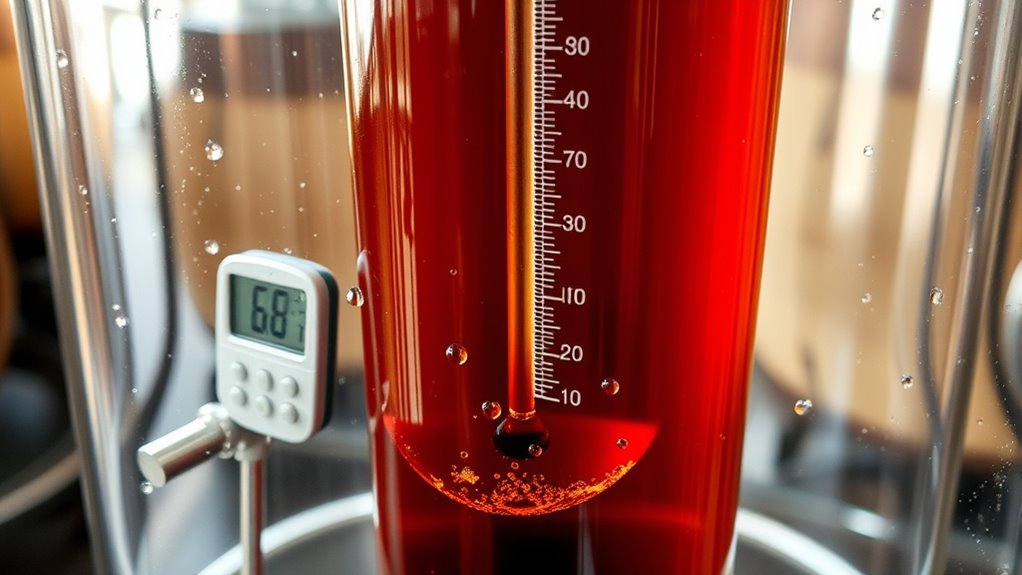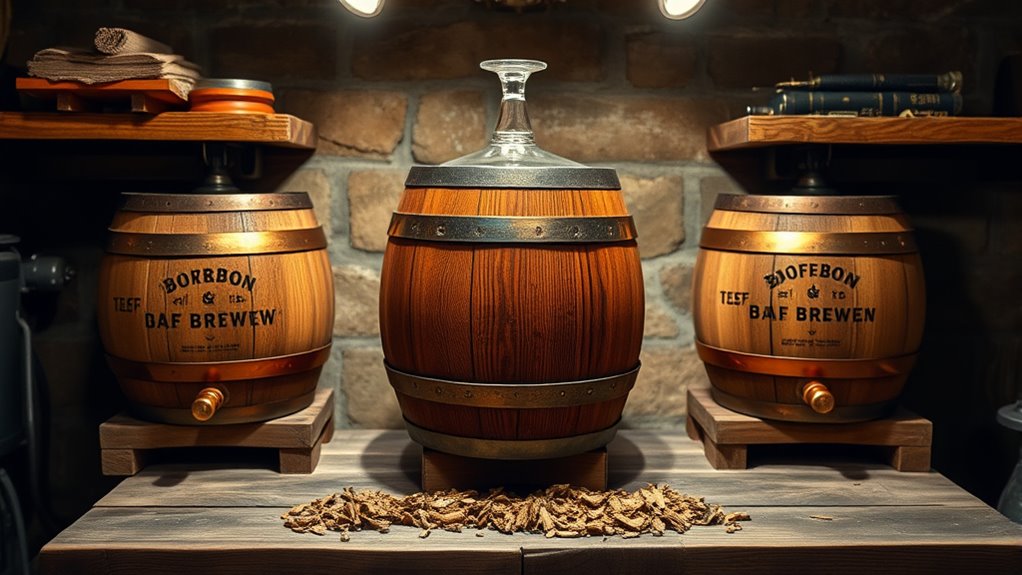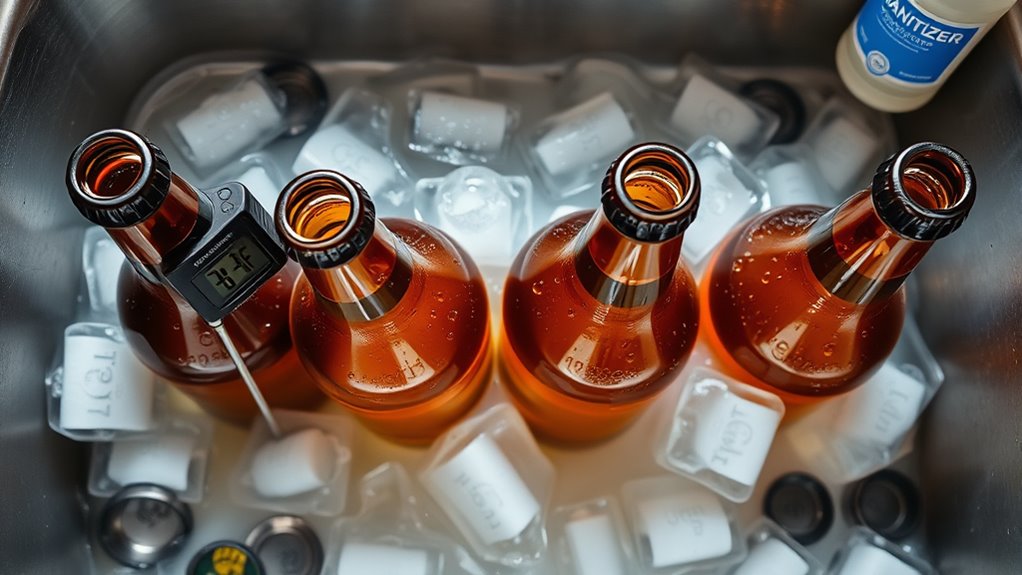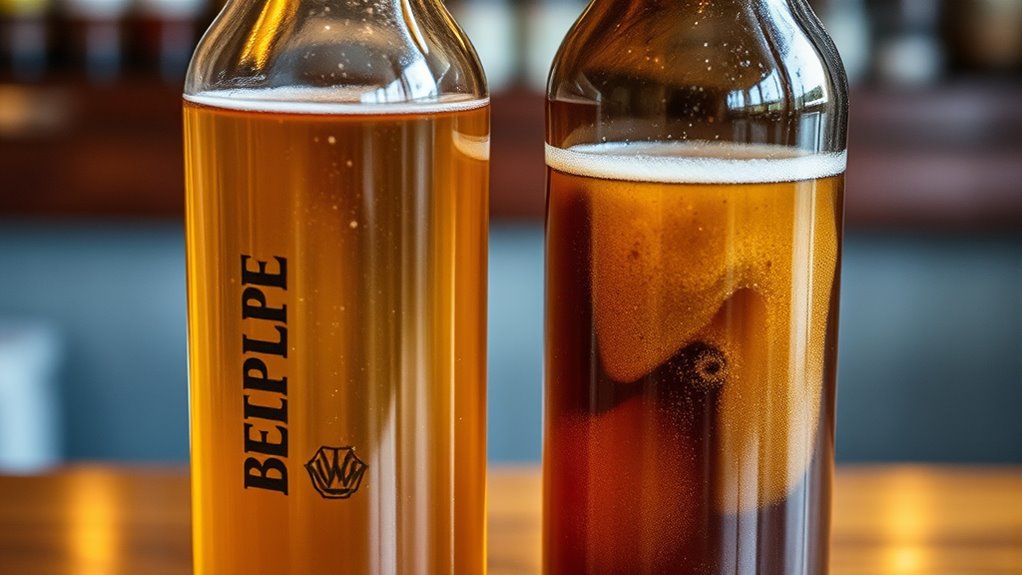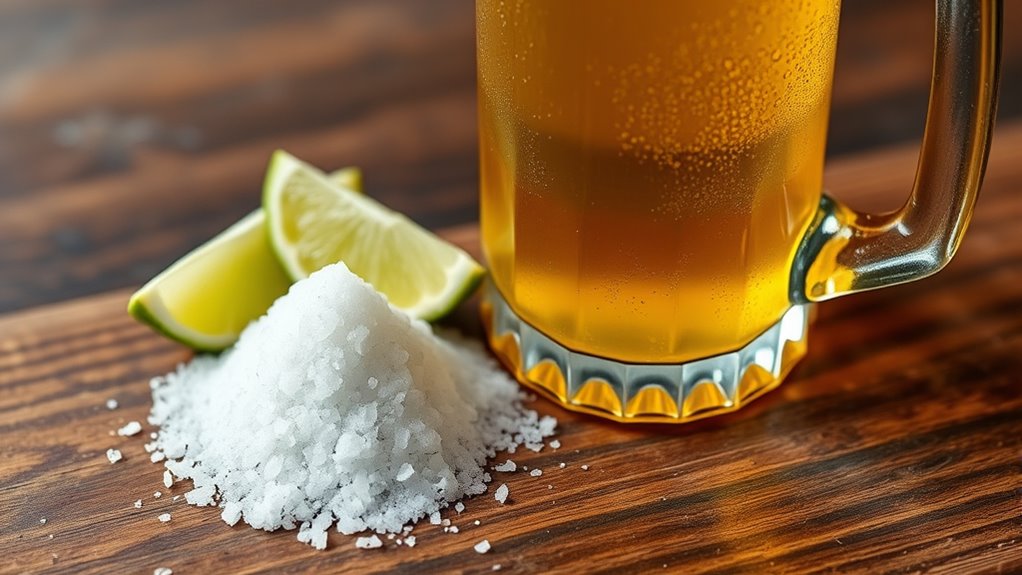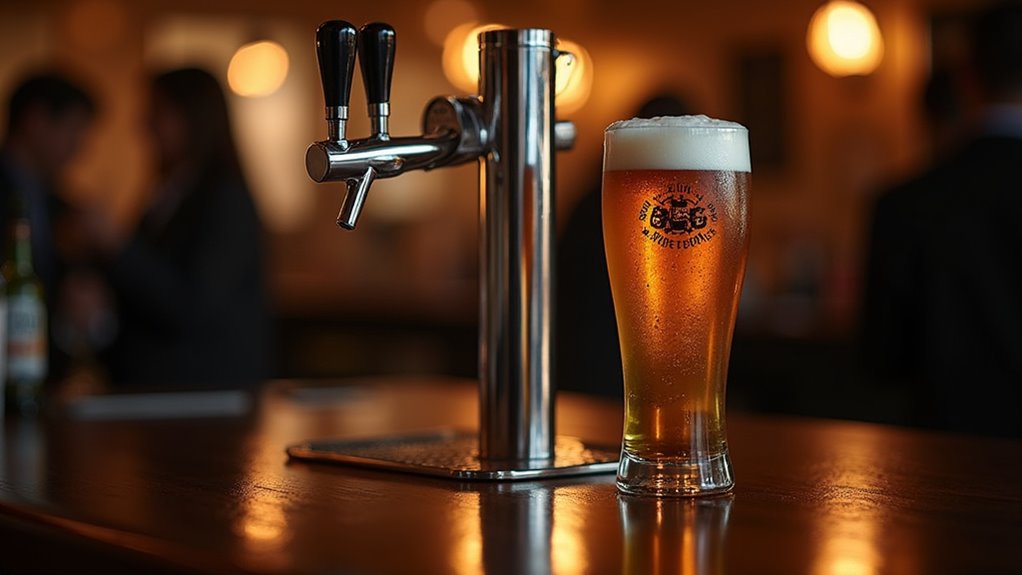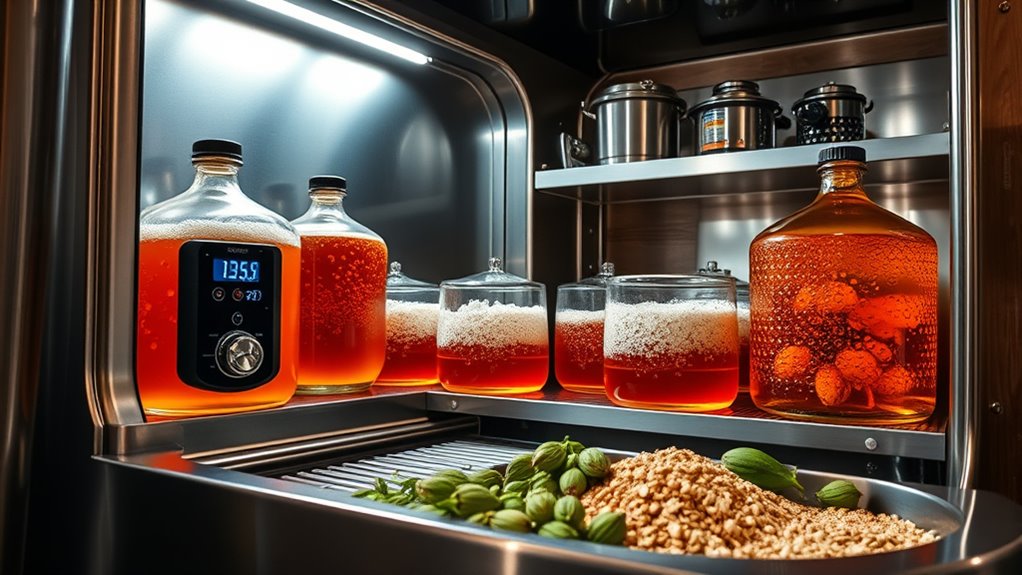To age homebrew beer effectively, you should maintain a consistent temperature around 55°F (13°C). This temperature helps develop complex flavors while preventing staling. For lighter ales, aim for 38-40°F (3-4°C). Avoid fluctuations in temperature, as they can lead to off-flavors. Always store your beer in a cool, dark place to minimize oxidation. Remember, proper aging makes a significant difference in taste, and there’s more to explore about enhancing your brewing experience.
At a Glance
- The ideal aging temperature for homebrew beer is around 55°F (13°C) to enhance flavor development.
- Lighter ales should be stored at cooler temperatures between 38°F to 40°F (3°C to 4°C).
- Dark beers, such as stouts and porters, age best at 55°F to 60°F (13°C to 15°C).
- Consistent temperatures are crucial; fluctuations can lead to off-flavors and spoilage.
- Regularly monitor storage conditions and taste samples to assess flavor development during aging.
Ideal Aging Temperature for Homebrew
When it comes to aging homebrew beer, maintaining the right temperature is essential for developing the best flavors and ensuring stability. The ideal aging temperature for homebrew is around 55°F (13°C). This temperature promotes the proper development of complex flavors while preventing staling.
If you’re using a fridge, keep it set to maintain this ideal aging temperature. For lighter ales, consider a cooler range of 38-40°F (3-4°C) to preserve consistency.
Remember, consistent temperatures are key; fluctuations can lead to unwanted off-flavors.
Helpful Hints:
- Store your beer in a cool, dark place.
- Avoid temperatures above 70°F (21°C).
Effects of Temperature on Beer Flavor
The temperature at which you store your homebrew beer greatly influences its flavor development and overall quality.
Aging beer around 55°F (13°C) is preferable, as it slows down the staling reaction rate, preserving your brew’s integrity. In contrast, raising the temperature by just 18°F (10°C) can double or triple this rate, leading to unwanted flavors like cardboard. Higher temperatures, particularly above 75°F, risk oxidation and yeast autolysis, introducing off-flavors. Consistency is key; fluctuating temperatures can disrupt flavor profiles. Additionally, minimizing oxygen exposure during storage is crucial to maintaining the quality of your beer.
Helpful Hints:
- Aim for 55°F for preferable aging.
- Monitor temperature carefully.
- Avoid drastic temperature changes.
Recommended Temperature Range for Different Beer Styles
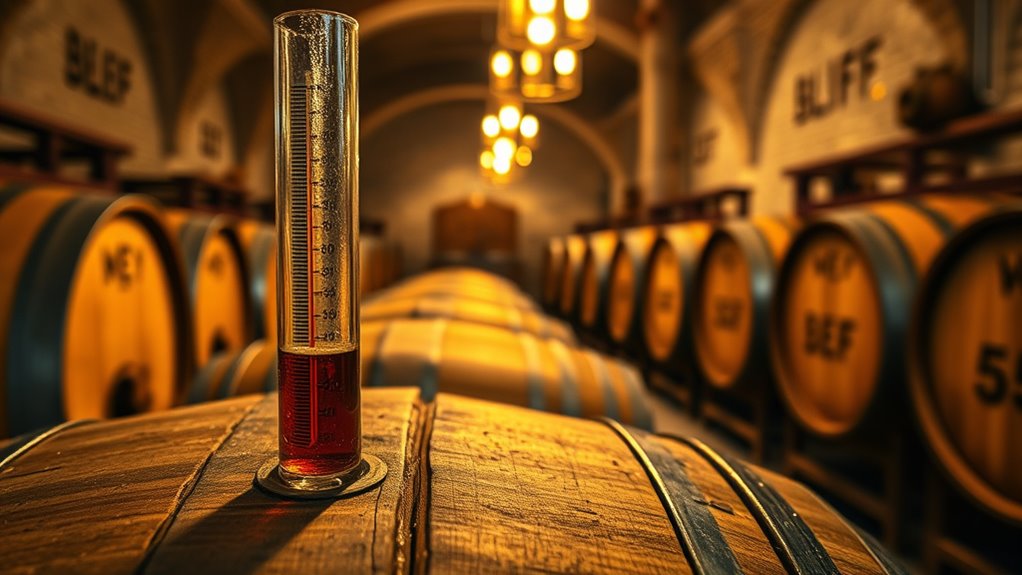
Understanding the recommended temperature range for aging different beer styles is essential for achieving ideal flavors and quality.
- Dark Beers: Stouts and porters age best between 55°F to 60°F (13°C to 15°C), enhancing their rich, complex flavors.
- Lighter Ales: Store these at cooler temperatures, preferably between 38°F to 40°F (3°C to 4°C), to maintain freshness and prevent off-flavors.
- Sour Beers: Aim for lower temperatures around 50°F to 55°F (10°C to 13°C) to control acidity and complexity.
Knowing these temperature guidelines allows for effective aging of various types of beer, ensuring a superior drinking experience.
Impact of High Temperatures on Aging
High temperatures can greatly affect the aging process of homebrew beer, often leading to undesirable changes in flavor and quality.
When you store your beer in conditions exceeding 95°F, oxidation accelerates, resulting in off-flavors akin to paper or cardboard. This staling reaction can double or triple with just a 10°C increase, drastically reducing the shelf life of your brew.
Yeast autolysis also speeds up, adding unpleasant flavors, especially in high-yeast beers. To protect your brew, use an aging rack in a cooler environment, ideally around 55°F, ensuring a smoother aging process and preserving its intended flavor profile.
Helpful Hints
- Avoid high temperatures above 95°F.
- Store in a dark, cool location.
- Monitor temperatures regularly.
Importance of Consistent Storage Conditions
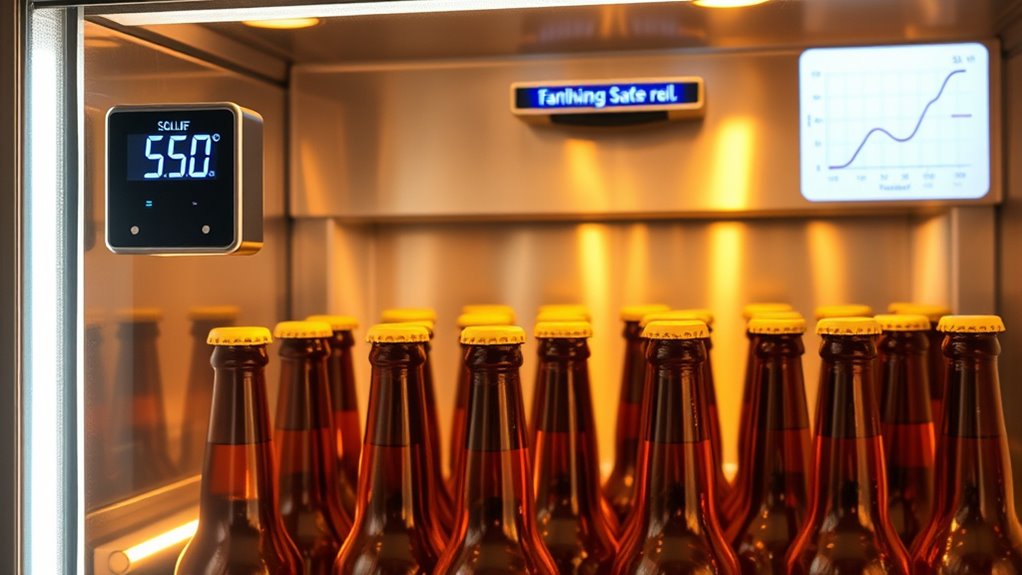
When you store your homebrew beer, maintaining consistent storage conditions is essential for achieving the best aging results. Fluctuations in temperature can accelerate the staling reaction rate, leading to off-flavors and spoilage.
Maintaining consistent storage conditions is crucial for aging homebrew beer and preventing off-flavors.
Ideally, aim for a consistent storage temperature around 55°F (13°C) for ideal aging. Remember, every 10°F increase can double or triple the staling rate, so a stable environment is key.
Store your beer in a cool, dark place to protect it from light exposure and temperature spikes. This will guarantee your brew ages gracefully and retains its intended flavors over time. Monitoring fermentation activity rate is also important, as it can provide insights into how well your beer will age.
Helpful Hints:
- Use a thermometer to monitor temperature regularly.
- Avoid locations with high temperature fluctuations.
- Consider a dedicated beer fridge for ideal conditions.
Best Practices for Monitoring Temperature
To achieve the best aging results for your homebrew beer, monitoring temperature effectively is key. Maintaining an aging temperature of 55°F (13°C) helps stabilize flavors and prevents oxidation.
Here are some helpful hints:
- Use a Brewing Thermometer: Invest in a reliable thermometer to track fluctuations, as even slight increases can accelerate staling reactions.
- Consider Temperature-Controlled Storage: A wine fridge can provide consistent conditions, especially in warmer climates.
- Log Your Readings: Keep a record of temperature changes to spot patterns that might impact flavor development.
Regular checks guarantee your beer ages efficiently, preserving its quality over time. Additionally, consistent temperature control is crucial during aging to prevent off-flavors and maintain the desired flavor profile.
Alternatives for Temperature-Controlled Storage
Finding suitable alternatives for temperature-controlled storage can make a significant difference in the aging process of your homebrew beer.
If you lack a dedicated fridge, consider using a wine fridge or a cooler set to around 55°F (13°C) to maintain consistent conditions. A cool closet or basement can offer a more stable environment than warmer areas like garages.
Insulating your storage space can also help manage temperature fluctuations. For smaller batches, a chest freezer with a temperature controller can create an excellent aging setting. Effective temperature management is key to avoiding temperature fluctuations that can negatively impact flavor and fermentation.
Regularly monitor the ambient temperature with a thermometer to guarantee ideal aging conditions.
Helpful Hints:
- Use a dedicated wine fridge.
- Insulate your storage area.
- Monitor temperature regularly.
Understanding the Aging Process
Understanding the aging process of homebrew beer is essential for achieving the best flavor and quality. Proper storage conditions play a key role in this process.
Here are some helpful hints for effective aging:
- Optimal Temperature: Aim for around 55°F (13°C) to maintain flavor stability.
- Consistent Environment: Fluctuations can spoil your beer’s flavor profile, so keep your aging rack stable.
- Style Matters: Dark beers, like stouts, benefit from longer aging, while lighter ales maintain flavor stability more easily. Additionally, barrel aging techniques can enhance the complexity of your beer’s flavor profile.
Common Mistakes in Beer Aging Temperature
When it comes to aging your homebrew beer, many common mistakes can derail the process, especially regarding temperature management.
For instance, storing beer above 75°F accelerates staling reactions, leading to off-flavors within months. Many brewers mistakenly think higher temperatures enhance aging, but exceeding 95°F can damage the flavor profile.
Additionally, light ales, best kept around 38-40°F, lose flavor stability quickly in warmer conditions.
Remember, proper temperature management is essential at all stages. Buying hops in bulk can also help maintain flavor integrity while aging your beer.
Helpful Hints:
- Aim for consistent storage around 55°F for long-term aging.
- Monitor temperatures closely to avoid oxidation.
Tips for Effective Homebrew Aging Techniques
Aging homebrew beer effectively requires attention to specific techniques that enhance flavor and stability. Here are three helpful hints to optimize your aging process:
- Use an Aging Rack: Store your bottles upright to minimize contact with the cap, reducing oxidation risks.
- Maintain a Temperature-Controlled Environment: Keep your beer at around 55°F (13°C) to slow down staling reactions and preserve flavor integrity.
- Regularly Sample Your Brew: Taste your beer periodically to gauge flavor development and determine when it reaches its peak profile, ensuring you enjoy it at its best.
